Memory decides: what is capable of i3 with good strapping?
Someone says that the production of processors is marking time, there is no progress and in general everything is ashes. In fact, modern CPUs have just reached the level where, for most simple everyday tasks, it doesn’t play a special role, what processor do you have - modern? Yes. Supports new instructions? Of course. Work in the browser on i7 and i3 will differ minimally, there are no problems with multimedia, even “Photoshop” will run almost equally until you go beyond the boundaries of reason. What then plays a role?
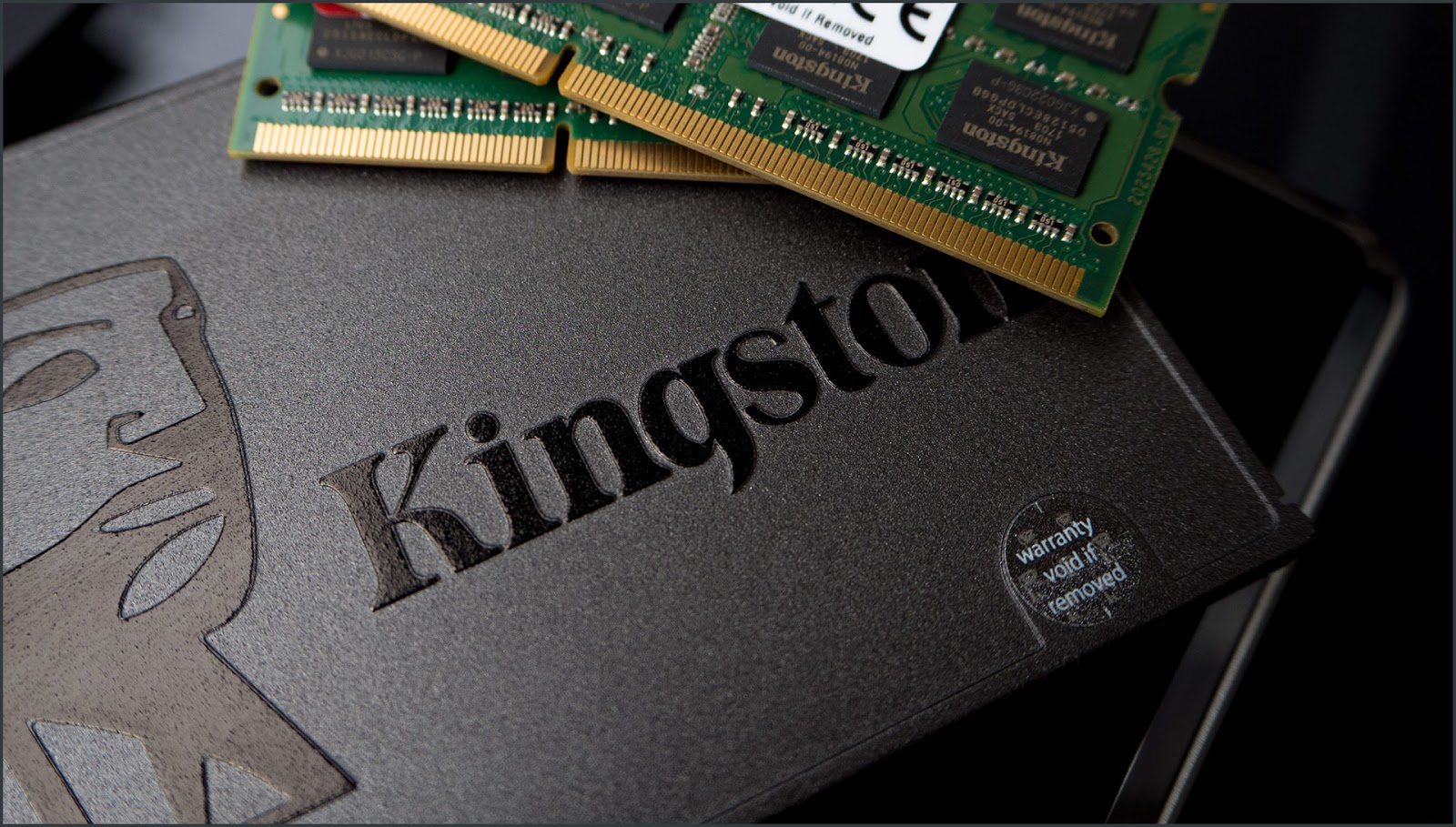
Of course, the iron that is in the “narrow spot” is the RAM and the drive. For the experiment, take the younger Core i3 two years ago (and even in the ULV-version) and complement it with modern RAM and high-speed SSD.
As a basis, we will use the Intel NUC based on the fifth-generation Intel Core processor. Kids-NUC'i quickly found their way into homes and offices - in fact, it is a barebone-clone Mac mini with the ability to put the “axis” that you need: not the most powerful machine, but cold, and therefore - quiet. However, on the topic of power, we bent a bit: this is our most modest model, and yet there is the NUC Skullcanyon with the quad-core i7 and Iris graphics.

Inside the box (not cardboard: there is only NUC, and a pulsed “feeder” with a bunch of forks for all occasions) a standard UCFF motherboard with an Intel Core i3-5010U processor soldered on it. Under the RAM, there are two SO-DIMM connectors, DDR3 and DDR3L memory are supported with 1.5 and 1.35 volt power supply respectively. You can install two drives. One will go to the M.2-connector for SSD, compatible with two types of connections at once - PCI-E x4 (and the NVMe instruction set) and SATA600. The second - the classic 2.5 "notebook" screw "with a thickness of 7.5 mm - is mounted in a sled on the bottom cover.
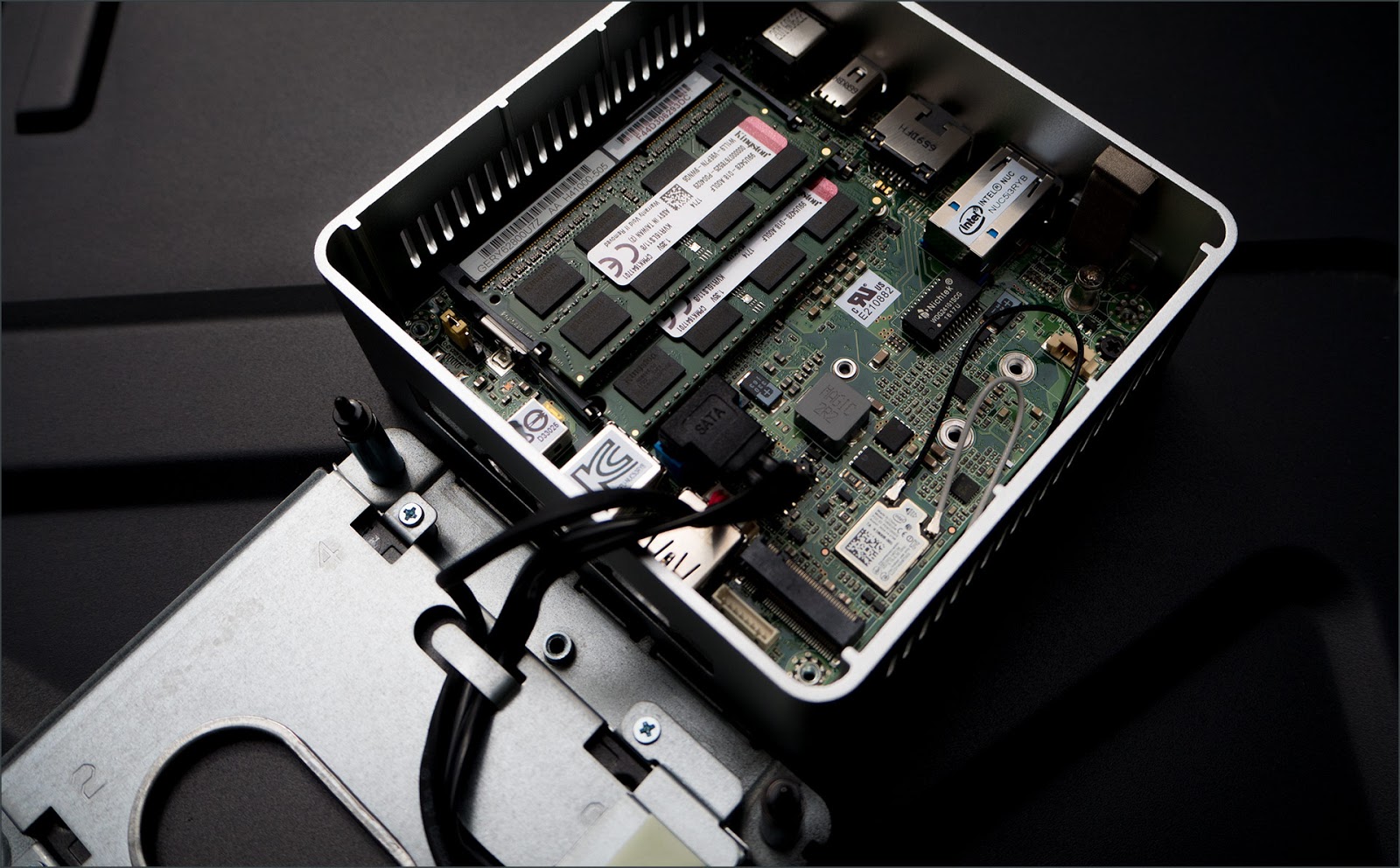
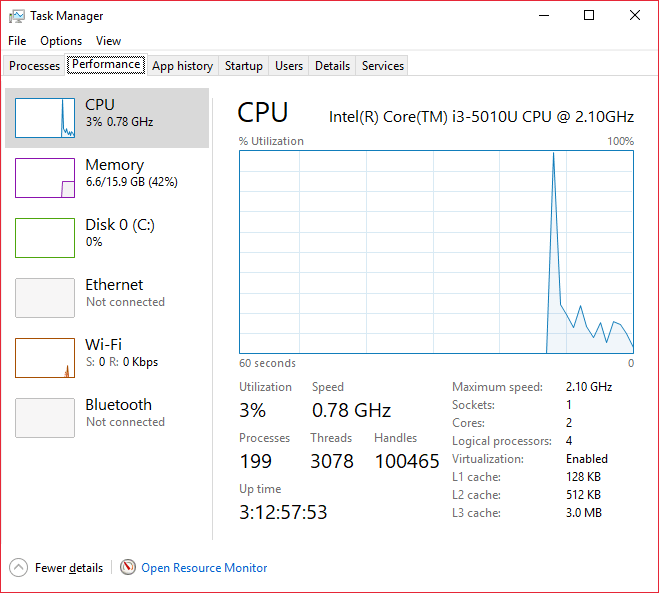
For this processor, 16 GB of memory with a frequency of 1600 MHz is the limit, 1866 MHz it does not support, and the maximum amount of memory is limited by Intel itself: you can install 2 modules of 16 GB each, but the system will not start. SSD Kingston A400, according to specifications, provides read speeds of up to 500 Mb / s and up to 450 records - a decent result for a SATA drive, especially since it is closely approaching the practical maximum of the SATA III technology itself.
For a start - a little synthetic. It is necessary to make sure that everything is functioning normally. We test the system disk with the ATTO Disk Benchmark — it is more accurate than the Crystal Disk Benchmark and uses several presets at once: you can see how the drive reacts to a change in the size of the data block.
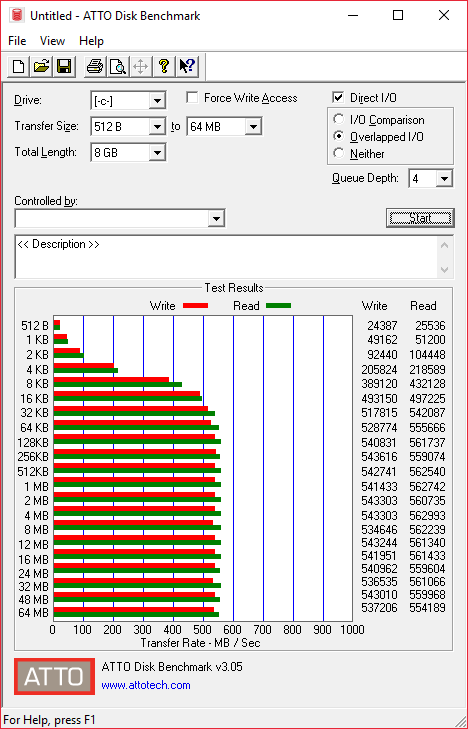
With a maximum load, the speeds are even higher than those stated!
RAM was fired through Memtest - no errors were detected. The processor was tested in SuperPi - it reached two million in 43 seconds. Let's go to the pratics part.
There are many ways to “squander” a machine in Photoshop: it’s enough to apply some resize with a factor of 0.66 to a file of 2,000 by 15,000 points with 70-80 layers, and even a six-core i7 with fifty GB of RAM will go into 100% load for a few minutes. We restrict ourselves to reasonable use - for example, batch processing of photos.
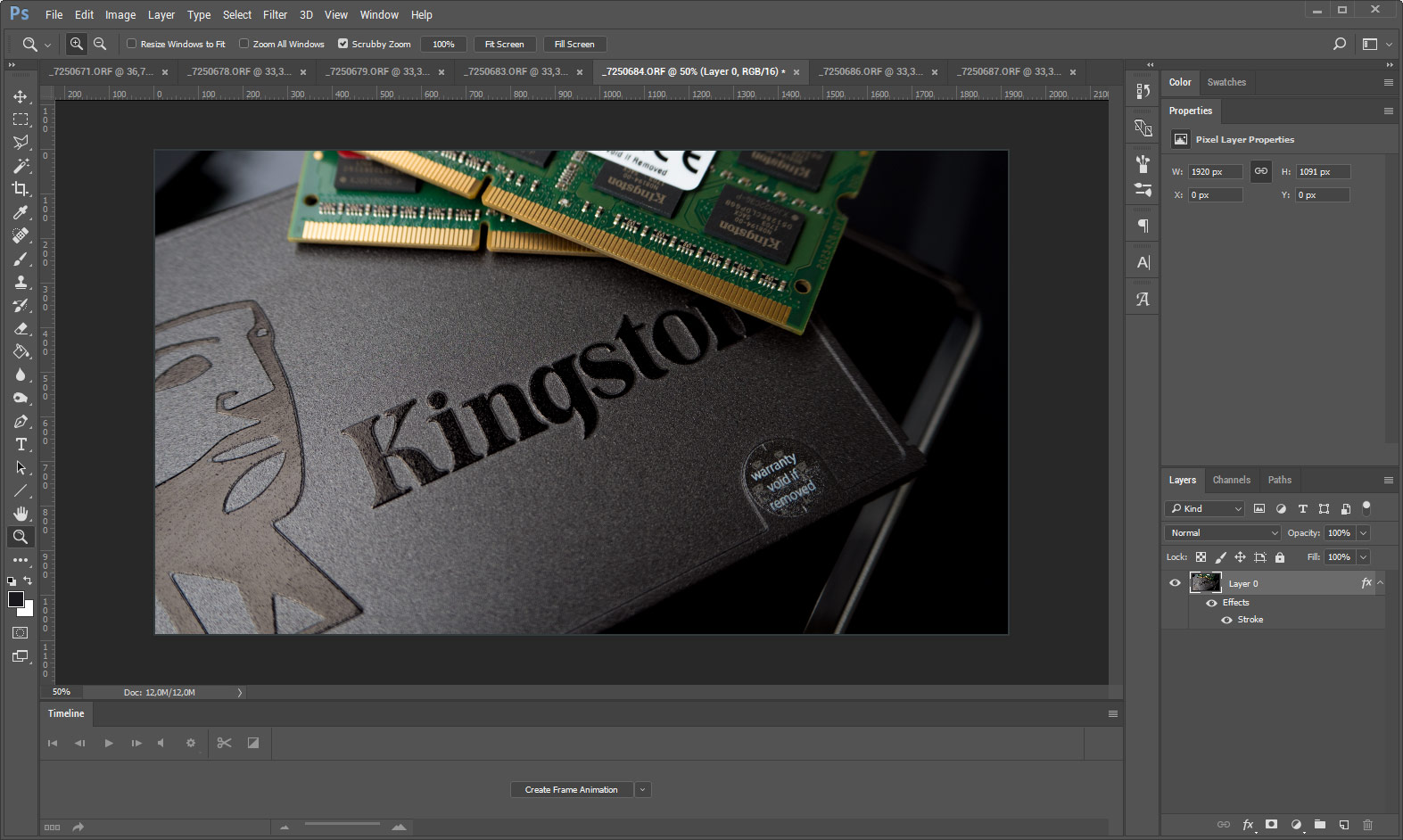
The RAW format of photos consumes a huge amount of memory during processing, since all changes are not applied to the original data set, but are stored separately and the color of each point is processed on the fly. Add from 12 to 18 bits of data per color channel (depending on the standard and camera model), complex logarithmic curves and dozens of parameters of the editing software itself: applying the exposure correction and color profile to a gigabyte of “source” can take several minutes.

Our NUC with its i3 processed 4 GB of photos from the “Igromir” last September only 30% slower than a laptop with i7-3565QM (4 cores @ 2.4-3.4 GHz) with 8 GB 1600 MHz of memory. The fact that the Intel Core i3-5010U is 2 cores less as if it did not affect the results - the same 30% is the difference in the clock frequency. The work with each photo separately (mainly retouching with a “stamp” and “treating brush”) did not differ at all. That is, fast memory in large quantities can compensate for the lack of computing power, if the task is appropriate.
Here, the power of the CPU, still occupies the main role. More cores, megahertz and cache - an archive is formed faster. Until your system is booted from any antediluvian flash drive via USB 2.0, and the files are read / written to it.
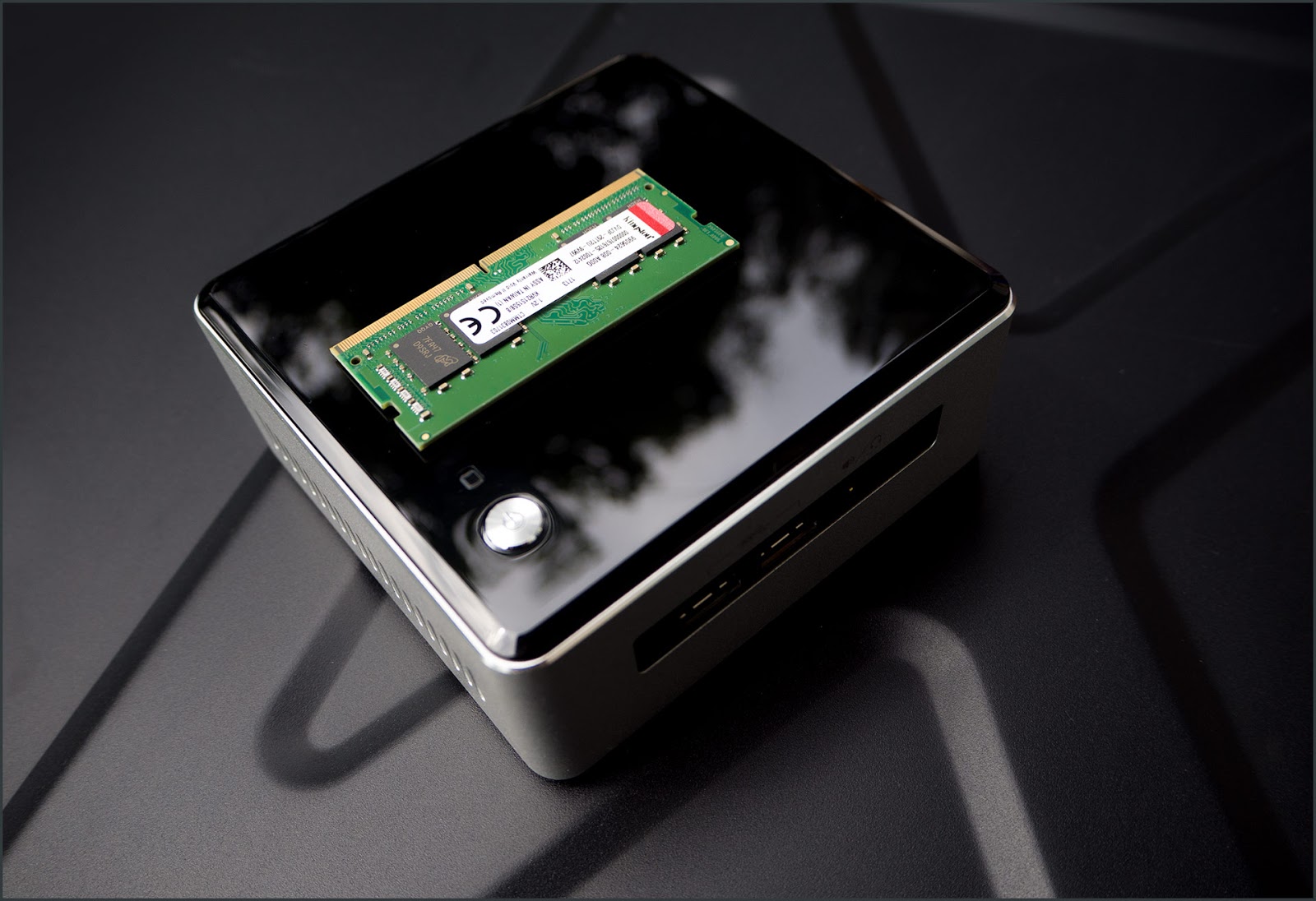
Yes, you can’t clear up with such hardware, and the younger i3 in conjunction with integrated graphics is hardly the best option for running modern AAA titles, but in games with competitive gameplay you can “relax”. Overwatch in FullHD and with 50% render scale produces> 30 FPS at medium settings. Replacing the SSD on the HDD leads to drawdowns of up to 20-24 frames per second: for some reason, the game ignores huge amounts of RAM.
A visually unpretentious Factorio may seem like a primitive load, which should not be taken into account. The first week of the game will be cloudless, your factory will work without problems (if you don't mess up anywhere) until you build something like this:
The game prefers to load all resources into RAM, but when it ends and it starts to aggressively use the paging file. With 16 GB of RAM, even the i3 with its two cores easily digests a huge production scale and withstands the attack of the last level bugs on the walls of the turrets.
The same laptop, despite the allocated 1 GB of video memory from the GT650M, surrenders to the second hour of the factory's work - the game starts to dull with any more or less active change in the current production. A freight train arrived at unloading - lags, attacked the base - write disappeared.
Junior i3 is quite capable of providing you with resources for work and entertainment. In a number of simple tasks, it catches up with five-year-old flagship processors, and again, NUCs are much more “evil” - with i5 and the same HD 5500 or i7 and high-performance Intel Iris 6100 graphics: great pieces of hardware in a compact package that can replace “ big brother "... if the storage system is not a bottleneck. In this way, you can easily pump a laptop that has ceased to please with speed - a good SSD gives the very feeling that the system “flies”, as if you changed the hardware of a decade ago to a new one.
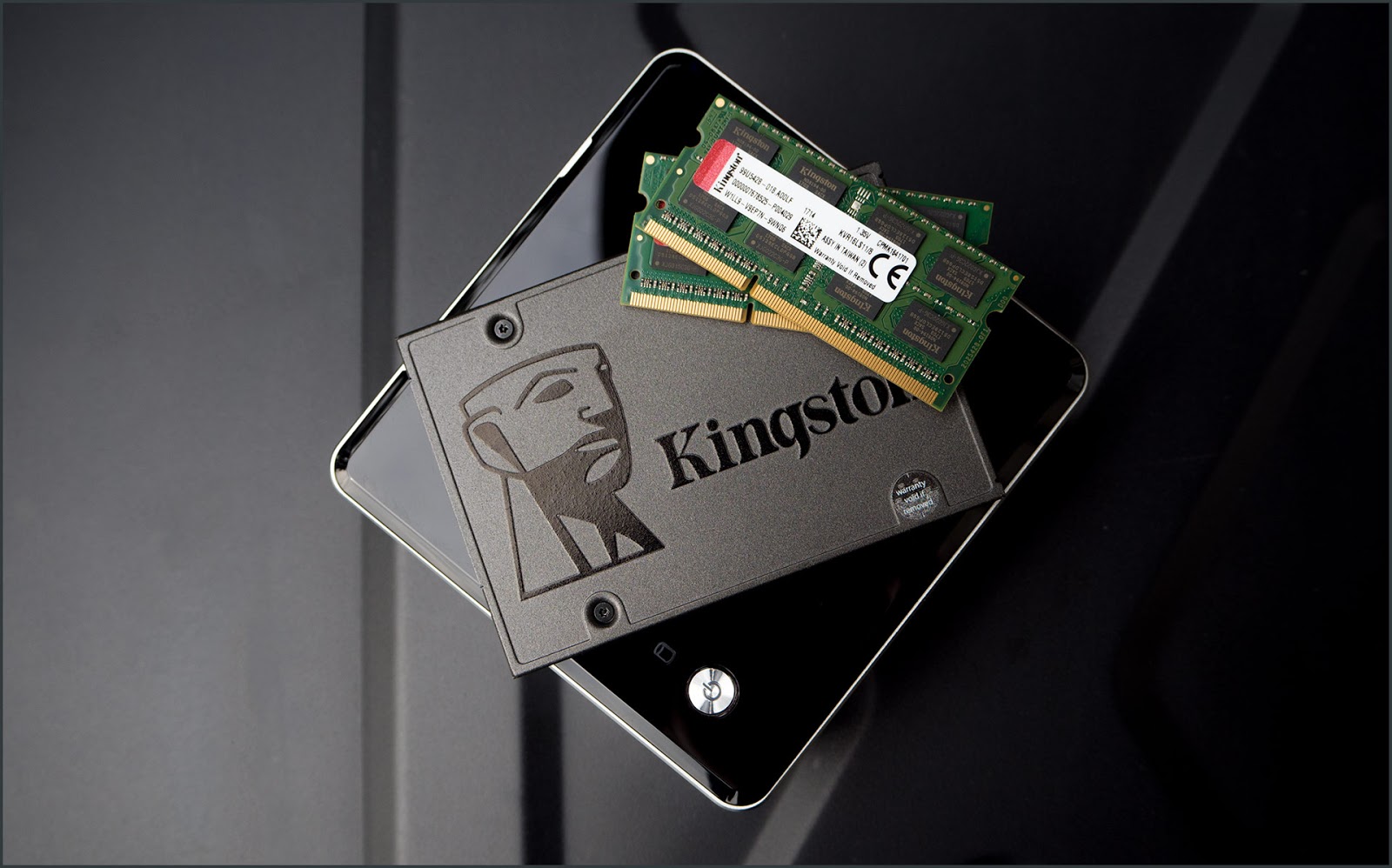
DNS sells memory for both DDR3 / DDR3L based laptops and new-fashioned DDR4 laptops. Of course, the M2 drives the whole car, both with the SATA protocol inside and high-speed, based on NVME. In general, there is nothing to choose from , without an upgrade you will not leave.
Subscribe and stay with us - it will be interesting!
For more information about Kingston and HyperX products, visit the company's official website . In choosing your kit HyperX help page with visual aids .

Of course, the iron that is in the “narrow spot” is the RAM and the drive. For the experiment, take the younger Core i3 two years ago (and even in the ULV-version) and complement it with modern RAM and high-speed SSD.
Test platform
As a basis, we will use the Intel NUC based on the fifth-generation Intel Core processor. Kids-NUC'i quickly found their way into homes and offices - in fact, it is a barebone-clone Mac mini with the ability to put the “axis” that you need: not the most powerful machine, but cold, and therefore - quiet. However, on the topic of power, we bent a bit: this is our most modest model, and yet there is the NUC Skullcanyon with the quad-core i7 and Iris graphics.

Inside the box (not cardboard: there is only NUC, and a pulsed “feeder” with a bunch of forks for all occasions) a standard UCFF motherboard with an Intel Core i3-5010U processor soldered on it. Under the RAM, there are two SO-DIMM connectors, DDR3 and DDR3L memory are supported with 1.5 and 1.35 volt power supply respectively. You can install two drives. One will go to the M.2-connector for SSD, compatible with two types of connections at once - PCI-E x4 (and the NVMe instruction set) and SATA600. The second - the classic 2.5 "notebook" screw "with a thickness of 7.5 mm - is mounted in a sled on the bottom cover.

Configuration
Processor: Intel Core i3-5010U (2 cores @ 2.1 GHz);
Video core: Intel HD 5500 (24 shader units, up to 900 MHz, 128-bit memory bus);
RAM: Kingston SO-DIMM DDR3L 1600 MHz (2 modules of 8 GB each);
Storage: Kingston A400 240 GB .

For this processor, 16 GB of memory with a frequency of 1600 MHz is the limit, 1866 MHz it does not support, and the maximum amount of memory is limited by Intel itself: you can install 2 modules of 16 GB each, but the system will not start. SSD Kingston A400, according to specifications, provides read speeds of up to 500 Mb / s and up to 450 records - a decent result for a SATA drive, especially since it is closely approaching the practical maximum of the SATA III technology itself.
Performance
For a start - a little synthetic. It is necessary to make sure that everything is functioning normally. We test the system disk with the ATTO Disk Benchmark — it is more accurate than the Crystal Disk Benchmark and uses several presets at once: you can see how the drive reacts to a change in the size of the data block.

With a maximum load, the speeds are even higher than those stated!
RAM was fired through Memtest - no errors were detected. The processor was tested in SuperPi - it reached two million in 43 seconds. Let's go to the pratics part.
Adobe Photoshop
There are many ways to “squander” a machine in Photoshop: it’s enough to apply some resize with a factor of 0.66 to a file of 2,000 by 15,000 points with 70-80 layers, and even a six-core i7 with fifty GB of RAM will go into 100% load for a few minutes. We restrict ourselves to reasonable use - for example, batch processing of photos.

The RAW format of photos consumes a huge amount of memory during processing, since all changes are not applied to the original data set, but are stored separately and the color of each point is processed on the fly. Add from 12 to 18 bits of data per color channel (depending on the standard and camera model), complex logarithmic curves and dozens of parameters of the editing software itself: applying the exposure correction and color profile to a gigabyte of “source” can take several minutes.

Our NUC with its i3 processed 4 GB of photos from the “Igromir” last September only 30% slower than a laptop with i7-3565QM (4 cores @ 2.4-3.4 GHz) with 8 GB 1600 MHz of memory. The fact that the Intel Core i3-5010U is 2 cores less as if it did not affect the results - the same 30% is the difference in the clock frequency. The work with each photo separately (mainly retouching with a “stamp” and “treating brush”) did not differ at all. That is, fast memory in large quantities can compensate for the lack of computing power, if the task is appropriate.
Archiving data
Here, the power of the CPU, still occupies the main role. More cores, megahertz and cache - an archive is formed faster. Until your system is booted from any antediluvian flash drive via USB 2.0, and the files are read / written to it.

Games
Yes, you can’t clear up with such hardware, and the younger i3 in conjunction with integrated graphics is hardly the best option for running modern AAA titles, but in games with competitive gameplay you can “relax”. Overwatch in FullHD and with 50% render scale produces> 30 FPS at medium settings. Replacing the SSD on the HDD leads to drawdowns of up to 20-24 frames per second: for some reason, the game ignores huge amounts of RAM.
A visually unpretentious Factorio may seem like a primitive load, which should not be taken into account. The first week of the game will be cloudless, your factory will work without problems (if you don't mess up anywhere) until you build something like this:
The game prefers to load all resources into RAM, but when it ends and it starts to aggressively use the paging file. With 16 GB of RAM, even the i3 with its two cores easily digests a huge production scale and withstands the attack of the last level bugs on the walls of the turrets.
The same laptop, despite the allocated 1 GB of video memory from the GT650M, surrenders to the second hour of the factory's work - the game starts to dull with any more or less active change in the current production. A freight train arrived at unloading - lags, attacked the base - write disappeared.
Fast memory is the key to high performance
Junior i3 is quite capable of providing you with resources for work and entertainment. In a number of simple tasks, it catches up with five-year-old flagship processors, and again, NUCs are much more “evil” - with i5 and the same HD 5500 or i7 and high-performance Intel Iris 6100 graphics: great pieces of hardware in a compact package that can replace “ big brother "... if the storage system is not a bottleneck. In this way, you can easily pump a laptop that has ceased to please with speed - a good SSD gives the very feeling that the system “flies”, as if you changed the hardware of a decade ago to a new one.

DNS sells memory for both DDR3 / DDR3L based laptops and new-fashioned DDR4 laptops. Of course, the M2 drives the whole car, both with the SATA protocol inside and high-speed, based on NVME. In general, there is nothing to choose from , without an upgrade you will not leave.
Subscribe and stay with us - it will be interesting!
For more information about Kingston and HyperX products, visit the company's official website . In choosing your kit HyperX help page with visual aids .
All Articles